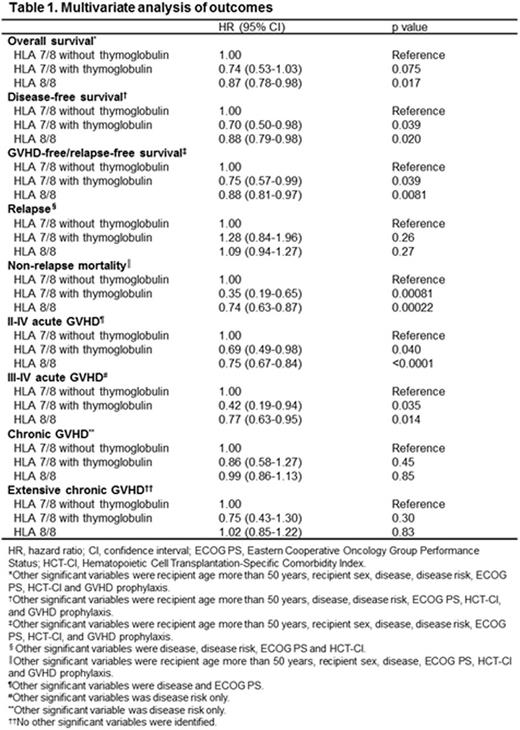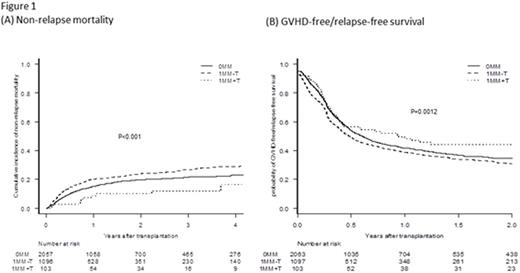Abstract
Introduction: HLA 1-locus mismatched unrelated donor (1MMUD) has been used in allogeneic hematopoietic stem cell transplantation (HCT) for patients who lack an HLA-matched related or unrelated donor, although its outcome has been shown to be inferior to that of HLA-matched HCT. The use of anti-thymocyte globulin such as thymoglobulin (Thymo) as GVHD prophylaxis may overcome this drawback. The aims of this study were to compare the transplant outcomes between 1MMUD and matched unrelated donor (MUD) and to evaluate the effectiveness of Thymo in unrelated HCT from 1MMUD using the recent cohort.
Methods: We retrospectively analyzed 3313 adult patients with acute myeloid leukemia (n=1835), acute lymphoblastic leukemia (n=830), or myelodysplastic syndrome (n=648) who underwent a first bone marrow transplantation from HLA -8/8 allele MUD or 1MMUD between 2009 and 2014. The patients who underwent allo-HCT from MUD with Thymo were excluded in this study. Clinical data for these patients were obtained from the Transplant Registry Unified Management Program (TRUMP), which includes clinical data of HCT performed in Japan. We compared the outcomes of MUD (n=2089) and 1MMUD with Thymo (n=109) with those of 1MMUD without Thymo (n=1115).
Results: The median total dose of Thymo was 2.5 mg/kg (range 1.0-11.0 mg/kg) in the 1MMUD with Thymo group. The incidence of grade II-IV and III-IV acute GVHD were 44.5% (95% confidence interval (CI), 41.5- 47.4%) and 13.1% (95% CI, 11.2-15.2%), 33.4% (95% CI, 24.5-42.5%) and 5.8% (95% CI 2.4-11.6%), and 36.1% (95% CI, 34.1-38.2%) and 10.5% (95% CI, 9.2-11.9%) in the 1MMUD without Thymo group, the 1MMUD with Thymo group, and the MUD group, respectively (p<0.001, and p=0.0085). The incidence of non-relapse mortality (NRM) at 3 years was higher in the 1MMUD without Thymo group (26.6%; 95% CI 23.7-29.5%) than that in the 1MMUD with Thymo group (11.9%; 95% CI, 5.9-20.2%) or the MUD group (21.4%; 95% CI 19.5-23.4%, p<0.001, Figure1A), although the incidence of relapse did not differ among 3 groups. The probabilities of GVHD-free, relapse-free survival (GRFS) at 1 year were 38.8% (95% CI, 35.8-41.8%), 48.4% (95% CI, 37.9-58.0%), and 41.8% (95% CI, 39.6-44.0%) in the 1MMUD without Thymo group, the 1MMUD with Thymo group, and the MUD group, respectively (p=0.0012, Figure1B).In multivariate analysis (Table 1), the rates of grade II-IV and III-IV acute GVHD, NRM and overall mortality were significantly lower in the MUD group than in the 1MMUD without Thymo group (hazard ratio (HR) 0.75; 95% CI 0.67-0.84; p<0.001, HR 0.77; 95% CI, 0.63-0.95; p=0.014, HR 0.74; 95% CI, 0.63-0.87; p<0.001, and HR 0.87; 95% CI, 0.78-0.98; p=0.017, respectively). Likewise, the rates of grade II-IV and III-IV acute GVHD and NRM were significantly lower in the 1MMUD with Thymo group than in the 1MMUD without Thymo group (HR 0.69; 95% CI 0.49-0.98; p=0.040, HR 0.42; 95% CI, 0.19-0.94; p=0.035, and HR 0.35; 95% CI, 0.19-0.65; p<0.001, respectively). In addition, the overall mortality rate also tended to be lower in the 1MMUD with Thymo group than in the 1MMUD without Thymo group (HR 0.74; 95% CI 0.53-1.03; p=0.075). On the other hand, there were no statistically significant differences in relapse rates between the 1MMUD without Thymo group and the MUD group (HR 1.09; 95% CI 0.94-1.27; p=0.27), or between the 1MMUD without Thymo group and the 1MMUD with Thymo group (HR 1.28; 95% CI 0.84-1.96; p=0.26). Finally, we divided patients in the 1MMUD with Thymo group into 3 groups according the total dose of Thymo (Thymo<2 mg/kg, 2 mg/kg≤Thymo≤4 mg/kg, Thymo>4 mg/kg), and compared the outcomes of the 3 groups with those of 1MMUD without Thymo. The incidence of NRM at 2 years and the probabilities of GRFS at 1 year were 16.1% (95% CI, 3.7-36.3%) and 33.8% (95% CI, 13.9-55.1%) in the Thymo<2 mg/kg group, 6.4% (95% CI, 1.6-16.0%) and 55.3% (95% CI, 40.6-67.8%) in the 2 mg/kg≤Thymo≤4 mg/kg group, 12.7% (95% CI, 3.0-29.6%) and 44.7% (95% CI, 25.1-62.6%) in the Thymo>4 mg/kg group, and 24.1% (95% CI, 21.5-26.8%) and 38.8% (95% CI, 35.8-41.8%) in the 1MMUD without Thymo group (p=0.014 and p=0.053), respectively.
Conclusions: The outcome of HCT from 1MMUD without Thymo was inferior to that of HCT from MUD even in the recent cohort. However, the negative impact of 1MMUD disappeared by the use of relatively low dose of Thymo without increasing the risk of relapse. A large prospective study is warranted to confirm the role of low dose of Thymo in HCT from 1MMUD.
Kanda:Otsuka Pharmaceutical: Honoraria, Research Funding.
Author notes
Asterisk with author names denotes non-ASH members.



This feature is available to Subscribers Only
Sign In or Create an Account Close Modal